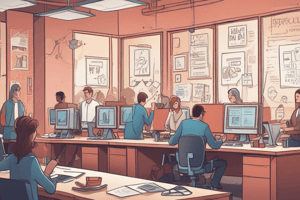Podcast
Questions and Answers
What best describes intrinsic rewards?
What best describes intrinsic rewards?
- Praise from colleagues or supervisors
- Pay increases given for performance
- Internal satisfactions felt during an action (correct)
- Promotions awarded by a manager
Which theory emphasizes the needs that motivate people?
Which theory emphasizes the needs that motivate people?
- Goal-setting theory
- Content theories (correct)
- Process theories
- Reinforcement theory
What is the main focus of reinforcement theory?
What is the main focus of reinforcement theory?
- Assigning tasks based on employee needs
- Creating ambitious goals for employees
- Developing intrinsic motivations
- Changing behavior through rewards and punishments (correct)
What does job enrichment involve?
What does job enrichment involve?
How does empowerment manifest in an organization?
How does empowerment manifest in an organization?
What characterizes the avoiding style of conflict resolution?
What characterizes the avoiding style of conflict resolution?
What is the first step in the organizational control process?
What is the first step in the organizational control process?
Which of the following is NOT a key performance metric included in the balanced scorecard?
Which of the following is NOT a key performance metric included in the balanced scorecard?
Which type of control relies on cultural values and trust?
Which type of control relies on cultural values and trust?
What is Six Sigma aimed at achieving?
What is Six Sigma aimed at achieving?
What does the liquidity ratio measure?
What does the liquidity ratio measure?
Which of the following is a purpose of benchmarking?
Which of the following is a purpose of benchmarking?
What type of budget estimates receipts and expenditures of money?
What type of budget estimates receipts and expenditures of money?
What is the primary characteristic of a self-managed team?
What is the primary characteristic of a self-managed team?
Which dysfunction of teams relates to a lack of support and accountability among members?
Which dysfunction of teams relates to a lack of support and accountability among members?
What best describes a task force?
What best describes a task force?
What defines the concept of groupthink in team dynamics?
What defines the concept of groupthink in team dynamics?
In team effectiveness, which outcome reflects members’ ability to learn and adapt?
In team effectiveness, which outcome reflects members’ ability to learn and adapt?
What is a characteristic of an agile team?
What is a characteristic of an agile team?
What does a socioemotional role primarily focus on?
What does a socioemotional role primarily focus on?
Which size range is considered optimal for high-performing teams?
Which size range is considered optimal for high-performing teams?
What type of conflict is characterized by disagreements about goals or tasks?
What type of conflict is characterized by disagreements about goals or tasks?
What is the primary focus of hygiene factors according to Herzberg?
What is the primary focus of hygiene factors according to Herzberg?
Which aspect of communication represents the process of interpreting symbols?
Which aspect of communication represents the process of interpreting symbols?
What does the term 'valence' refer to in expectancy theory?
What does the term 'valence' refer to in expectancy theory?
Which communication network allows individuals to communicate freely with other team members?
Which communication network allows individuals to communicate freely with other team members?
What percentage of effective communication is attributed to listening?
What percentage of effective communication is attributed to listening?
What is the definition of communication apprehension?
What is the definition of communication apprehension?
According to ERG theory, which of the following needs is NOT classified under growth needs?
According to ERG theory, which of the following needs is NOT classified under growth needs?
What is meant by 'open communication' in an organization?
What is meant by 'open communication' in an organization?
Which type of motivational factor has the greatest impact on job satisfaction according to Herzberg?
Which type of motivational factor has the greatest impact on job satisfaction according to Herzberg?
What does a 'centralized network' imply about team communication?
What does a 'centralized network' imply about team communication?
What is the primary distinction between intrinsic and extrinsic rewards?
What is the primary distinction between intrinsic and extrinsic rewards?
How do process theories differ from content theories in motivation?
How do process theories differ from content theories in motivation?
Which aspect of empowerment is most crucial for organizational effectiveness?
Which aspect of empowerment is most crucial for organizational effectiveness?
What is the main purpose of job redesign in an organization?
What is the main purpose of job redesign in an organization?
What does the job characteristics model primarily focus on?
What does the job characteristics model primarily focus on?
Which aspect of Total Quality Management involves groups of employees meeting to address quality-related issues?
Which aspect of Total Quality Management involves groups of employees meeting to address quality-related issues?
The balanced scorecard includes which of the following key performance metrics?
The balanced scorecard includes which of the following key performance metrics?
What is the primary goal of Six Sigma in quality management?
What is the primary goal of Six Sigma in quality management?
Which type of control emphasizes the use of rules and policies to shape employee behavior?
Which type of control emphasizes the use of rules and policies to shape employee behavior?
What is meant by the term 'Kaizen' in the context of organizational improvement?
What is meant by the term 'Kaizen' in the context of organizational improvement?
Which of the following best describes a cash budget?
Which of the following best describes a cash budget?
Which ratio indicates how well an organization can meet its short-term obligations?
Which ratio indicates how well an organization can meet its short-term obligations?
The systematic process of monitoring and adjusting organizational activities to align with plans is known as:
The systematic process of monitoring and adjusting organizational activities to align with plans is known as:
What role does positive reinforcement play in behavior management?
What role does positive reinforcement play in behavior management?
Which of the following best describes the concept of valence in expectancy theory?
Which of the following best describes the concept of valence in expectancy theory?
Which type of communication involves messages being sent down from top management to subordinates?
Which type of communication involves messages being sent down from top management to subordinates?
What does the term 'communication apprehension' refer to?
What does the term 'communication apprehension' refer to?
In ERG theory, which category of needs involves the desire for personal growth?
In ERG theory, which category of needs involves the desire for personal growth?
What is central to the concept of open communication within an organization?
What is central to the concept of open communication within an organization?
What is the primary focus of hygiene factors according to Herzberg's theory?
What is the primary focus of hygiene factors according to Herzberg's theory?
Which communication network allows for unrestricted exchange of messages among team members?
Which communication network allows for unrestricted exchange of messages among team members?
What aspect of communication is primarily addressed through feedback mechanisms?
What aspect of communication is primarily addressed through feedback mechanisms?
How is the concept of 'channel richness' relevant to communication?
How is the concept of 'channel richness' relevant to communication?
What is a defining characteristic of a self-managed team?
What is a defining characteristic of a self-managed team?
What role does a task specialist play in a team?
What role does a task specialist play in a team?
What is the primary effect of team diversity?
What is the primary effect of team diversity?
Which dysfunction of teams is associated with reluctance to express differing opinions?
Which dysfunction of teams is associated with reluctance to express differing opinions?
What describes the accommodating style of conflict resolution?
What describes the accommodating style of conflict resolution?
What is the main focus of the socioemotional role in a team?
What is the main focus of the socioemotional role in a team?
Which of the following is a characteristic of a special-purpose team?
Which of the following is a characteristic of a special-purpose team?
What outcome reflects a team's capacity to adapt and learn?
What outcome reflects a team's capacity to adapt and learn?
During which stage of team development do teams typically experience conflict and disagreement?
During which stage of team development do teams typically experience conflict and disagreement?
What does team cohesiveness primarily refer to?
What does team cohesiveness primarily refer to?
Flashcards
Motivation
Motivation
The forces that drive us to act, either within or external to us.
Intrinsic Rewards
Intrinsic Rewards
The internal satisfaction you get from doing something.
Extrinsic Rewards
Extrinsic Rewards
Rewards given by others, like promotions or bonuses.
Empowerment
Empowerment
Signup and view all the flashcards
Engagement
Engagement
Signup and view all the flashcards
Avoiding Conflict Style
Avoiding Conflict Style
Signup and view all the flashcards
Organizational Control
Organizational Control
Signup and view all the flashcards
Balanced Scorecard
Balanced Scorecard
Signup and view all the flashcards
Decentralized Control
Decentralized Control
Signup and view all the flashcards
Total Quality Management (TQM)
Total Quality Management (TQM)
Signup and view all the flashcards
Six Sigma
Six Sigma
Signup and view all the flashcards
Liquidity Ratio
Liquidity Ratio
Signup and view all the flashcards
Feedback (work)
Feedback (work)
Signup and view all the flashcards
Autonomy
Autonomy
Signup and view all the flashcards
Expectancy Theory
Expectancy Theory
Signup and view all the flashcards
E → P Expectancy
E → P Expectancy
Signup and view all the flashcards
P → O Expectancy
P → O Expectancy
Signup and view all the flashcards
Valence
Valence
Signup and view all the flashcards
ERG Theory
ERG Theory
Signup and view all the flashcards
Hygiene Factors
Hygiene Factors
Signup and view all the flashcards
Communication
Communication
Signup and view all the flashcards
Team
Team
Signup and view all the flashcards
Functional team
Functional team
Signup and view all the flashcards
Cross-functional team
Cross-functional team
Signup and view all the flashcards
Task force
Task force
Signup and view all the flashcards
Self-managed team
Self-managed team
Signup and view all the flashcards
Free rider
Free rider
Signup and view all the flashcards
Lack of Trust
Lack of Trust
Signup and view all the flashcards
Team Cohesiveness
Team Cohesiveness
Signup and view all the flashcards
Groupthink
Groupthink
Signup and view all the flashcards
Accommodating style of conflict resolution
Accommodating style of conflict resolution
Signup and view all the flashcards
Content Theories
Content Theories
Signup and view all the flashcards
Process Theories
Process Theories
Signup and view all the flashcards
Reinforcement Theory
Reinforcement Theory
Signup and view all the flashcards
Job Enrichment
Job Enrichment
Signup and view all the flashcards
Job Characteristics Model
Job Characteristics Model
Signup and view all the flashcards
Open Communication
Open Communication
Signup and view all the flashcards
Benchmarking
Benchmarking
Signup and view all the flashcards
What are the 5 stages of team development?
What are the 5 stages of team development?
Signup and view all the flashcards
What is a "cross-functional team"?
What is a "cross-functional team"?
Signup and view all the flashcards
What is a "free rider" in a team?
What is a "free rider" in a team?
Signup and view all the flashcards
What is "task conflict"?
What is "task conflict"?
Signup and view all the flashcards
What is "team cohesiveness"?
What is "team cohesiveness"?
Signup and view all the flashcards
What is the "performing" stage of team development?
What is the "performing" stage of team development?
Signup and view all the flashcards
What is "groupthink"?
What is "groupthink"?
Signup and view all the flashcards
What are the "socioemotional" roles within a team?
What are the "socioemotional" roles within a team?
Signup and view all the flashcards
What is the "accommodating" style of conflict resolution?
What is the "accommodating" style of conflict resolution?
Signup and view all the flashcards
What are the three outcomes of effective work teams?
What are the three outcomes of effective work teams?
Signup and view all the flashcards
Study Notes
Motivation
- Motivation is the internal or external force that drives enthusiasm and persistence towards a goal.
- Intrinsic rewards are internal feelings of satisfaction achieved through action.
- Extrinsic rewards are external rewards like promotions, praise, and pay raises.
- Content theories focus on understanding employee needs.
- Process theories explain how people choose actions to fulfil needs.
- Reinforcement theory examines the relationship between behavior and its consequences, focusing on modifying employee behavior with rewards/punishments.
- Empowerment is delegating power and authority to subordinates.
- Engagement is an employee's emotional and mental state, marked by enjoyment of work, goal contribution, and organizational commitment.
Job Design
- Job design applies motivational theories to structure work, improving employee productivity and satisfaction.
- Job enrichment introduces high-level motivators like responsibility, recognition, growth, and learning opportunities into the work.
- Work redesign modifies jobs to increase employee productivity and job quality.
- The job characteristics model identifies core job dimensions, essential psychological states, and employee growth needs.
Goal Setting and Motivation
- Goal difficulty involves making high-ambitious but achievable goals.
- Feedback is the information employees receive on their performance.
- Autonomy relates to the degree of freedom and self-determination an employee has in performing tasks.
- Expectancy theory explains how employees' expectations impact motivation, including expectancy concerning effort, performance, and outcomes.
- Valence relates to the value of the outcomes.
- ERG theory modifies the need hierarchy theory, proposing three need categories: existence, relatedness, and growth.
- Motivators, according to Herzberg, are critical for job satisfaction, based on fulfilling higher-level needs.
- Belongingness needs are for acceptance by peers, friendships, group affiliation, and love.
- Positive reinforcement involves administration of pleasant consequences for desired behavior.
- Hygiene factors represent lower-level needs, impacting satisfaction when absent.
Communication
- Communication is the exchange and understanding of information to influence or motivate behavior.
- Encoding involves message creation and selection of a channel.
- Decoding involves interpretation of the message.
- Message is the tangible form of an idea.
- Feedback is a response from the receiver to the sender.
- Vision is an attractive and realistic attainable future.
- Communication apprehension is associated fear or anxiety in communication.
- Open communication involves sharing information inside an organization across different functions and levels.
- Centralized networks focus communication through a one central person.
- Decentralized networks permit open communication between team members.
- Channel richness refers to how much information a channel transmits.
- Social media platforms are used for user generated content.
- Personal communication networks may cut across organizational levels.
- Nonverbal communication relates to human actions and behavior.
Teams
- A team is a group of two or more who interact and coordinate work to accomplish a common objective.
- Team cohesiveness relates to the attraction and motivation team members have for their respective teams.
- Stages of team development include Forming, Storming, Norming, Performing, and Adjourning.
- A functional team consists of a manager and subordinates.
- A cross-functional team comes from different departments at the same hierarchy level.
- Task forces are temporary groups for specific tasks, while special-purpose teams are created to deal with important projects.
- Self-managed teams perform tasks and rotate jobs within the group.
- Agile teams are focused on specific aspects of a project, including members with the required expertise.
- Team benefits include creativity, speed, productivity, lower costs, and employee satisfaction.
- Virtual teams are geographically diverse.
- Global teams involve people from various countries.
- Common dysfunctions of teams include lack of trust, fear of conflict, lack of commitment, avoidance of accountability, and inattention to results.
- Team effectiveness relates to satisfaction, productive output, and adaptability.
- Team diversity (of diverse skills, knowledge etc.) is linked to innovative solutions.
- Member roles focus on task performance and social satisfaction.
- Conflict can lead to task conflict and relational conflict.
- Team norms outline behaviors related to work and expectations.
Organizational Control
- Organizational control regulates organizational activities.
- Establishing performance standards, measuring actual performance, comparing performance to standards, and taking corrective action are part of the process.
- Total quality management (TQM) implements quality control across entire organizations through continuous effort.
- Quality circles are groups of employees involved in improving processes.
- Benchmarking is the process of measuring a company in terms of products, services, and processes.
- Six Sigma aims for a goal of 3.4 defects per million parts for high quality and efficiency standards.
- Quality partnering emphasizes quality improvements across different departments.
- Kaizen (continuous improvement) involves incremental improvements in different areas for greater efficiency.
- Expense budget outlines anticipated and actual expenses for a defined responsibility center.
- Cash budget estimates receipt and expenditures to ensure adequate cash flow.
- Financial control focuses on financial statement analysis for managing an organization's financial well-being.
Financial Ratios
- Liquidity ratios show an organization's ability to meet current debt obligations.
- Activity ratios describe internal performance in relation to key activities.
- Profitability ratios show profits compared to sales or assets.
- Return on assets represent percentage of earnings from assets.
- A balance sheet provides information regarding assets, liabilities, and owners' equity.
Studying That Suits You
Use AI to generate personalized quizzes and flashcards to suit your learning preferences.
Related Documents
Description
This quiz focuses on key theories of motivation and job design that drive employee engagement and satisfaction. Explore intrinsic and extrinsic rewards, empowerment, and the application of motivational theories in structuring work for improved productivity. Test your understanding of how these concepts influence workplace dynamics.




